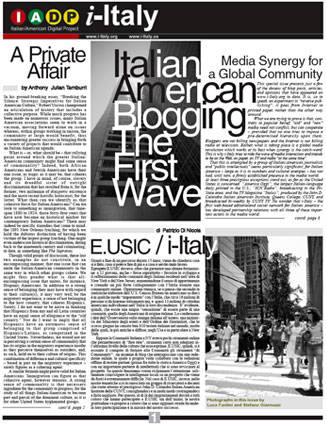From the Net to the Paper...
This print edition represents, so to speak, an experiment in “reverse publishing”: it goes from Internet to printed paper, rather than the other way around.
What we are trying to prove is that, contrary to popular belief, “old” and “new” media need not conflict, but can cooperate provided that no one tries to impose a pre-determined hierarchy upon them. Bloggers are not killing newspapers and the Internet is not killing radio or television. Rather, what is taking place is a global media revolution which works at its best when synergy is the catch-word. This is why i-Italy tries to ride the wave of media interaction and intends to be on the Web, on paper, on TV and radio “at the same time”.
That this is attempted by a group of Italian/American journalists and “public intellectuals” seems particularly significant, for Italian America – large as it is in numbers and cultural energies – has not had, until now, a firmly established presence in the media world. At least three prestigious exceptions stand out, as far as the United States is concerned: “America Oggi”, the largest Italian-language daily printed in the U.S.; “ICN Radio”, broadcasting in the Tri-State area; and the TV Magazine “Italics”, produced by the John D. Calandra Italian American Institute, Queens College, CUNY, and broadcasted by CUNY TV. No wonder that i-Italy – the first web-based editorial and social network for Italian America – has developed partnership relations.
i-Italy, thus, is a digital project – an attempt at digital integration of different media using the Internet as a platform. And the nature of this project is both editorial and social. It couln’t be different, and it shouldn’t. Information, in the Internet era, is not any longer a top-down activity. But neither is it, contrary to common demagogical assumptions, a mere bottom-up process. Information is – or is becoming – the natural product of an endless, horizontal, ubiquitous process of social conversation. This is the philosophy on which i-Italy is based. We intend to provide Italian America with a tool to build multiple, interrelated conversational networks and to distil, from this very social activity, an information product useful – we hope – to all.
The dual nature of this endeavor can be gathered by looking at how our site is developed. On the one hand, we have an open-access community available to everybody (www. i-Italy.us). In just a few months after its launch, we have hundreds of registered users who write, discuss, connect, and exchange opinions and information. This is our main conversation lounge, but it is also the place where users have participated in our first “Citizen Journalism/Digital Witness Contest” sponsored by Alitalia. People are using this community site to share posts, videos, and photographs, and have created dozens of forums and discussion groups on virtually any kind of topic. Groups range from Nutella lovers to Movi.Menti (mainly in Italian language, it is dedicated to Italians abroad “looking for their lost country”), from Italian American Filmmakers & Artists to Terre Promesse, a group where Italians living in Italy and in the U.S. look at how the two countries are portrayed in the media and pubic opinion. One of the most active discussion groups is Women in Italy and Italian women in the world, where several issues are being debated including this one: “How do you feel, as a woman, about finally having a woman run for president?”. Other less structured conversations go on in our forums, mainly about heritage and immigration, Italian/American identity, family stories, food and “made in Italy” products. Some comments have been posted in a forum dedicated to the now world-famous New York Times article about Italy’s “funk”. Finally, keep in mind that the activity of these registered users is just the tip of the iceberg; up until now i-Italy.us has attracted the curiosity of over 10,000 unique visitors resulting in about 100,000 page views.
At the next level are the “bloggers” – i.e. users who have applied, or have been invited to become regular contributors to our daily editorial work. This special printed issue presents just a few of them… others – many others – will come next time. Bloggers are independent journalists, writers, and commentators whose regular contributions keep the site’s content fresh and updated. What they do – be it articles, videos or audio podcasts – is then examined at a third level (the editorial board) and published in the Magazine, Specials, or Multimedia sections at www.i-Italy.org. There are no filters to include or exclude contributions here, just ordinary decisions about the best section and timing for publication, and some attention to “netiquette”.
To summarize, what we are attempting to create with i-Italy, and with surprising results, is an experiment of interaction between professional journalists, citizen journalists, and public intellectuals – academics and experts willing to leave the university’s ivory tower and become involved in public debate. This approach, in line with the spirit of web 2.0, is founded on a conversation-andinformation process in which social interaction and user-created content predominate.
The success of this initiative has persuaded us to establish a not-for-profit cultural institution called the Italian/American Digital Project whose mission is to manage the journalistic and cultural content of i-Italy and to research the necessary resources to ensure that this project will continue in the years to come.
The project is open to all users online who are interested in Italy and Italian America. Come and visit us!
CLICK BELOW TO DOWNLOAD THE 8-PAGE SPECIAL PRINT EDITION OF i-ITALY



































i-Italy
Facebook
Google+
This work may not be reproduced, in whole or in part, without prior written permission.
Questo lavoro non può essere riprodotto, in tutto o in parte, senza permesso scritto.